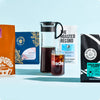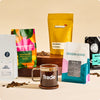If we zoom in on American coffee shop culture, it may seem like cold brewed beverages are a relatively new phenomenon. If you’re like most people, you’d probably never tried — or perhaps even heard of — cold brew before the mid-2010s. You might even be surprised to learn that cold brewing as a technique dates back to before 1600, pioneered in Kyoto, Japan for brewing tea. To this day, Kyoto slow-drip towers are still used to brew all sorts of delicious drinks.
A Brief History
In the early 1600s, shortly after Dutch spies stole the coffee plant from African people at the Port of Mocha, Dutch trading ships began serving coffee as a boiled-down concentrate to avoid the risk of starting a fire in order to get caffeinated (this was before the days of electric kettles). In the over 400 years since, cold brew has gone through numerous resurgences and stages of evolution, eventually finding a home in a variety of coffee shops across the world.
But what is cold brew coffee? The answer is right there in the name: it’s coffee brewed by steeping grounds in cold water as opposed to hot water, usually for an extended period of time.
Breaking it Down
Although this may come as a surprise, cold brewing is actually one of the simplest and most approachable ways to brew coffee. All you need is a good cold brew maker (like this Hario Mizudashi cold brewer), very coarsely ground coffee, cold or room temperature filtered water, and time.
But how does it work, anyway? Without getting too scientific, cold water extracts flavor from coffee way more slowly than hot water, so grounds typically need to steep anywhere between 12 and 18 hours in order to produce a delicious and balanced cup. The coarse grind size allows water to flow freely through all areas of the filter, extracting flavor from each particle evenly (imagine water trying to flow through marbles as opposed to sand). The extended contact time allows flavors to develop more slowly, which is why cold brew tends to boast deep, rich flavors.
Just like with most numbers in coffee brewing, these are merely suggestions, with some brew recipes calling for as short as eight hours in brew time. Realistically, you can finish brewing whenever your coffee tastes right to you, and the relatively few variables involved in cold brewing means it's ripe for extensive experimentation.
You might be thinking, "But iced coffee already exists! Why would I spend all day when I can make a delicious cup of iced coffee in less than five minutes?” Well, there are some significant differences between cold brew and traditional iced coffee that may sway you one way or the other.
Before diving into that, it’s important to note that contrary to what some people assert, neither type of cold coffee is inherently superior. As with all beverages, the best drink for you is simply whichever one you personally prefer.
How is cold brew different from iced coffee?
Baristas generally make iced coffee by first brewing hot coffee at approximately two times its normal strength, then diluting it with ice to reach a normal coffee to water ratio, typically around 1:16. (That being said, no judgment if you’re one of the many home brewers who frequently enjoys second-day hot-brewed coffee that you left overnight in the fridge to cool). For best flavors, folks typically use a process called flash-brewing, which is a fancy way of saying they brew their coffee over ice rather than adding ice at the end.
Iced coffee has a high acidity that’s comparable to its hot counterpart, which makes sense considering it’s initially brewed that way. It’s great for highlighting floral, citrus, and other bright flavors, making it the cold coffee of choice for those who enjoy light or medium roast coffees. However, richer flavors may become muddled as the coffee cools, leading many dark roast drinkers to lean away from brewing iced coffee. In terms of batch size, it’s logistically a bit difficult to brew big batches at home, since doing so would require not only a large brewer, but also an abundance of ice at the ready.
On the other hand, cold brew typically boasts rich flavors and a full body (think heavier on the tongue, like whole milk as compared to nonfat milk). Cold brew is often celebrated for its characteristically low acidity and bitterness, which may make it easier on the stomach, and for some folks is simply a flavor preference.
Due to a number of surely fascinating but unnecessary scientific details, cold brew also holds onto its flavor for longer than iced coffee. It’s also particularly easy to brew in large batches. These factors combined make cold brew a great option for all you meal-prep types, because you can brew a bunch at once and drink it throughout the week.
Contrary to popular belief, cold brew does not inherently contain more caffeine than traditional iced coffee. However, it’s common to brew cold brew as a concentrate. If the brewer neglects or chooses not to dilute this concentrate before drinking it, then it would in fact contain more caffeine — but so would hot coffee, if it were brewed at that strength.







